
DPINTERFACE EXCLUSIVE: I’ve just posted my review of the Olympus E620 digital SLR, a 12 megapixel digital SLR with a 4 FPS burst mode, Art Filters and new TruePic III+ processor – it’s just like a ‘baby E30’ (which in turn is the ‘baby E3’). You can also check out photos taken straight out of the camera in the Olympus E620 photo gallery. Hit the link for the full review.
DPInterface is the first independent camera review website to publish a full, final review of the E620. This review was written based on a full production, retail unit of the Olympus E620.
DPInterface Olympus E620 Review
Brad Soo – April 13th, 2009 (Updated April 27th, 2009)
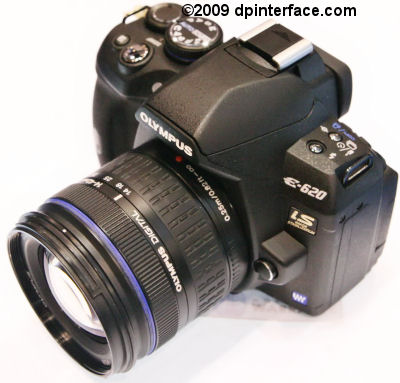
The E620 is the middle child of Olympus’ E30 and E520 digital SLRs – it has a feature set similar to the former but takes after the latter’s relatively compact form factor. Here is what’s up on the Olympus E620:
- 12 effective megapixels
- Super Sonic Wave Filter (SSWF) dust reduction system
- New TruePic III Plus imaging processor (the E30 has this too)
- Flip out-and-twist rotating 2.7 inch LCD
- Live view with contrast detection focus and face detection
- 4 frames per second burst mode
- 7 point autofocus (5 twin cross type)
- ISO range of 100 - 3200
- Art Filters feature and backlit controls
That’s a pretty darn good set of features and it sounds like the ultimate street photography camera when paired with a pancake lens like the Olympus Zuiko 25 mm f2.8. Everyone’s also been harping on a review of the E620 for two continuous months now, since its introduction in February… Is the Olympus E620 really that fantastic? Find out now!!
This review was written based on a full-production, retail unit Olympus E620 with firmware version 1.00.
Size and Weight
(288.2) 128.8 x 97.5 x 61.9 mm (480 g) – Canon EOS Digital Rebel T1i aka EOS 500D
(284.0) 126.0 x 94.0 x 64.0 mm (495 g) – Nikon D60
(311.0) 127.0 x 104.0 x 80.0 mm (560 g) – Nikon D5000
(284.0) 130.0 x 94.0 x 60.0 mm (475 g) – Olympus E620
(258.8) 124.0 x 89.6 x 45.2 mm (385 g) – Panasonic Lumix G1/GH1
(281.0) 122.5 x 91.0 x 67.5 mm (525 g) – Pentax K2000 aka K-m
(304.0) 130.8 x 98.5 x 74.7 mm (582 g) – Sony Alpha A350
All the weight figures above show when the camera is empty without any lens, battery or memory card
The Olympus E620 is the slimmest and lightest digital SLR camera in its class (the Panasonic G1/GH1 are exceptions; they don’t have any mirror box or optical viewfinder). The only real protrusions on the E620 are its flash and viewfinder cup areas, and paired with a pancake lens, you could just leave that camera bag at home while you go out shooting.
The E620 is also quite a bit smaller and lighter than the latest entrant into the market, the Nikon D5000 (it has a flip down and rotate LCD).
Box packaging
The Olympus E620 comes with the typical digital SLR camera bundle, nothing extra:
- BLS-1 rechargeable lithium-ion battery
- Battery charger
- Body cap
- Eyepiece cover
- Neck strap
- USB and video cables
- Camera software disc (Olympus Master)
- User’s manual
- Olympus Zuiko Digital 14 – 42 mm f3.5 – f5.6 lens (with kit lens option)
You can opt to purchase the Olympus E620 body only (RRP of $700), or get the camera with the 14 – 42 mm kit lens (RRP of $800). I believe there are also two more kit lens options but they’re not available everywhere – a dual lens option includes the mentioned 14 – 42 mm lens plus the Olympus Zuiko 40 – 150 mm f4.0 – f5.6 lens; and ‘pancake kit’ bundles the E620 with the Olympus 25 mm f2.8 pancake lens.
The Olympus E620 is just like any other digital SLR out there in the sense it doesn’t come with a memory card neither does it have any built-in memory. The E620 has two memory card slots; it supports xD-Picture cards in one slot and Compact Flash (Type 1 and Type 2) cards in the other. I’d recommend sticking to the latter as your primary card, as Compact Flash cards are typically cheaper, faster and available in MUCH larger capacities (32 GB as of today and growing!) and are more commonly used versus xD cards. Of course, that doesn’t stop you from sticking an xD Picture card into the other slot and using it as a backup card.
The Olympus E620 is able to take advantage of high-speed cards (including UDMA CF cards) to improve shot-to-shot times and perform faster in general. I would recommend getting at least a 4 GB high-speed Compact Flash card with the camera. Go ahead and pick up larger, higher speed cards if you want – they’ll do you a lot of good.
500 shots – Canon EOS Digital Rebel T1i aka EOS 500D
190 shots – Canon EOS Digital Rebel T1i aka EOS 500D (LCD live view)
500 shots – Nikon D60
510 shots – Nikon D5000
500 shots – Olympus E620
300 shots – Panasonic Lumix GH1 (LCD live view)
330 shots – Panasonic Lumix G1 (LCD live view)
640 shots – Pentax K2000 aka K-m
730 shots – Sony Alpha A350
410 shots – Sony Alpha A350 (LCD live view)
All the cameras above are rated with rechargeable batteries according to CIPA Standard; when using the viewfinder, unless noted otherwise
The Olympus E620 uses the BLS-1 lithium-ion rechargeable battery and comes with a charger. In terms of battery life, it gets about 500 shots per charge (CIPA Standard) using the optical viewfinder. Olympus doesn’t say what kind of numbers you’ll get when using live view, but my testing reveals the camera can take around 200 shots when using live view all of the time.
Accessories
The Olympus E620, as you’d expect from a digital SLR, is compatible with a large range of accessories. For starters, the E620 supports all Four Thirds standard lenses (including any third party ones that may come along); all being subjected to the sensor’s 2.0X focal length multiplication factor.
You can also add on external flash units to the camera and attach flash brackets to hold those external flashes. Olympus has FL-36R and FL-50R flash models, both of which support wireless flash functionality. You can also opt for third party flash units, but only Olympus models will sync automatically with the camera.

You can also improve battery life of the E620 by using the optional HLD-5 battery grip. The battery grip also serves as a way to comfortably hold the camera in a portrait position. Olympus offers wired and wireless remote control options for the camera as well as a waterproof case. The Olympus PT-E06 waterproof case allows you to bring the E620 down to 40 meters deep.
There are also other things like camera bags and cases… but strangely no AC adapter available for the camera.
Camera Tour
The Olympus E620 is relatively compact for a digital SLR… and the world’s smallest and lightest digital SLR with built-in image stabilization, according to Olympus. With that in mind, and despite the lack of a ‘real’ right hand grip, the camera is still easy to hold and feels well balanced in hand. Holding the camera is no problem but operation can be a little intimidating for first-time users or beginners moving up from point-and-shoot cameras – the Olympus E620 has as many buttons, maybe more, compared to a mid-range digital SLR camera. Some of the buttons are also a tad small and hard to press at times; especially the ones right next to the LCD.
Speaking of buttons, many of the back controls are backlit (navigation pad and surrounding buttons, MENU and INFO buttons) for easy viewing in the dark. Build quality was pretty good for a camera of this class, and the E620 is mostly plastic with some metal elements and rubber textures here and there.
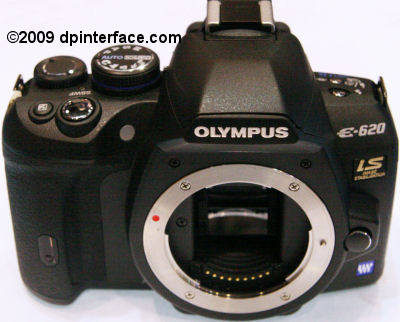
The first thing you’ll see the E620’s Four Thirds lens mount, with the camera’s 12.3 effective megapixel LiveMOS sensor behind it. You can attach any Four Thirds system lens onto the camera; with the usual 2X crop factor of the sensor, that means any lens you attach will be subjected to a 2X multiplication factor (ie the 14 – 42 kit lens becomes equivalent to 28 – 84 mm in 35 mm terms).
The Olympus E620 also features Olympus’ SuperSonic Wave Filter dust reduction system, which works very well by ‘shaking’ off the dust on the filter in front of the sensor. In addition, the E620 has sensor-shift image stabilization which helps reduce the effects of camera shake and allows you to shoot up to 4 stops slower than normal (the 1/focal length rule).
On the right is a large shiny button for ejecting the lens and directly above the lens mount is the camera’s popup flash unit. The flash is released electronically via the flash button on the top of the camera and has a guide number of 12 m at ISO 100, which is average versus other digital SLRs. The flash is also used for autofocus assist, where it fires strobes of lighting to illuminate your subject.
The camera’s remote receiver is located on the grip as well as the self-timer light. Further up, next to the shutter button, is a small white circle – that’s the new white balance sensor which wasn’t available on previous cameras and promises improved automatic white balance on the E620.
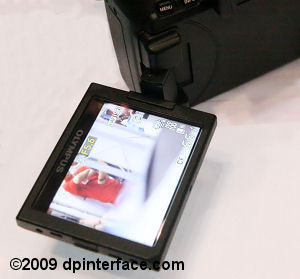

The Olympus E620 features a flip-out and rotate style 2.7 inch LCD. You can flip the LCD screen out 180 degrees and rotate it up to 270 degrees to face upwards (low angle shots from the hip), face to the front (self-portraits) or downwards (high angle shots above the heads in a crowd). The screen can also be faced inwards (closed) to protect the LCD.
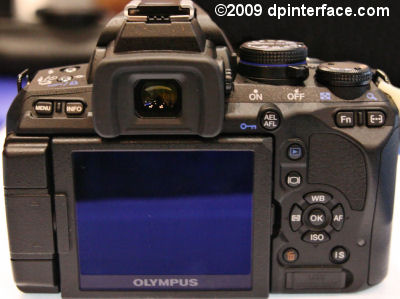
The 2.7 inch HyperCrystal III LCD has 230,000 pixels – it’s sharp and very viewable in both low-light (using the boost function) and bright light. Quite obviously, you’ll be using the screen in live view mode and the rotating LCD feature comes in handy a lot.
Directly above the LCD panel is the E620’s optical viewfinder. The viewfinder shows a good amount of information; but is a bit on the small side (For a digital SLR) with 0.96X magnification and 95% coverage. Inside the viewfinder chamber, you’ll also get to see info about autofocus, exposure, flash and general shooting details (ie remaining shots). It also has dioptric correction, adjustable via the knob to the right of the viewfinder.
To the left of the viewfinder are two buttons. One is MENU button while the INFO button, used to toggle LCD display information. To the upper right corner of the Olympus E620 are two buttons: one is the Function button while the other is for focus point selection. The Function button can be assigned to one of many
To the right side are the rest of the E620’s controls. The first one is the exposure/focus lock button (it doubles to protect/unprotect images in playback), followed by the direct playback and live view buttons. The live view button toggles the Olympus E620’s live view function on/off.
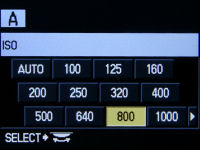
Next up is the five way navigation pad, used for navigating menus and, like on a compact camera, they also provide direct access to a few functions:
- Up – White balance (Auto, daylight, cloudy, shade, tungsten, fluorescent 1, 2 & 3, flash, custom, white balance adjustment)
- Down – ISO sensitivity (Auto, 100 – 3200 in choice of 1/3 or 1 step increments)
- Left – Metering mode (ESP multiple, center weighted, spot, spot highlight, spot shadow)
- Right – Autofocus mode (Single, continuous)
- Center – OK/Super Control Panel
In continuous focusing, the camera focuses continuously to reduce time from pressing the shutter to the shot being taken. However, this setting is not available in live view mode. The E620 also features advanced white balance controls – you can either set color temperature (from a range of 2,000 to 14,000 Kelvin) or adjust white balance up to +/-7 steps along the amber-blue and green-magenta axis’s respectively.
The two buttons at the bottom are for deleting photos and image stabilization mode respectively. The Olympus E620 has three sensor-shift image stabilization modes – Mode 1 is your usual ‘compensate for camera shake’ image stabilization while Mode 2 and Mode 3 are for vertical and horizontal panning respectively. I wished Olympus put some sort of tooltip or indicator for each image stabilizer mode instead of just calling them IS 1, IS 2 and IS 3 in the menu.
At the very bottom is a single connectivity for both USB and video out with a rubber cover over it.
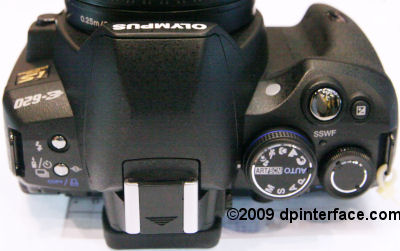
Hey wait, we’re not done yet! There’s a couple more buttons and dials at the top of the Olympus E620. On the left are button for flash and drive mode respectively. The camera’s built-in flash is popped up via the first press of the Flash button, and from there, you can select one of many flash modes: auto, auto with redeye reduction, slow sync (1st or 2nd curtain), flash on, flash off or manual power (1/1, 1/4, 1/16 or 1/64).
The other button lets you change the camera’s drive mode; from single-shot, high-speed continuous, low-speed continuous, self-timer (2 or 12 seconds) or remote control (wired or wireless). High-speed mode is fixed at 4 frames per second while low-speed mode allows you to pick a continuous shooting speed between 1 to 3 frames per second. The drive mode button can be reprogrammed via the Custom Function menu and doubles as the camera’s print/transfer button in playback.
Next to that is the camera’s built-in flash unit along with an external flash hotshoe. You can use any flash with the camera but only Olympus ones will sync automatically with the camera. The Olympus E620 can sync as fast as 1/180 sec with an external flash or up to 1/4000 using Super FP mode with an external flash. If you’re feeling creative, then you can create a wireless flash setup (using either Olympus FL50R or FL36R flash units) of up to 3 groups and 4 channels; and control them directly from the camera!
To the right side, there’s the Olympus E620’s mode dial:
- Manual mode – you get full control over both shutter speed and aperture; bulb mode up to 30 minutes is available
- Aperture priority – pick an aperture value (depends on lens) and the camera will select a matching shutter speed
- Shutter priority – pick a shutter speed (between 1/4000 to 60 seconds in your choice of 1/3, 1/2 or 1 step increments) and the camera will select a matching aperture value
- Program mode – the camera will select both shutter speed and aperture; there’s Program Shift available so you can tweak the shutter/aperture combinations
- Automatic shooting
- Portrait mode
- Landscape mode
- Close-up mode
- Sports mode
- Night portrait mode
- Art Filters/Other scene modes
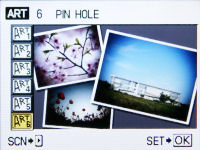
The Olympus E620 is the second Olympus camera to have a set of Art Filters (they were first seen on the Olympus E30).



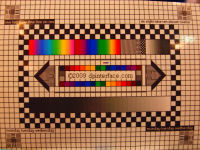
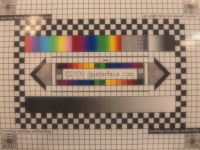
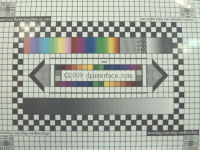



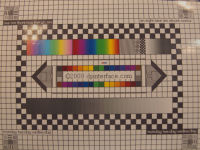
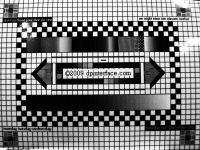
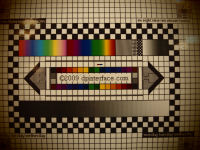
Basically, Art Filters applies a certain effect to photos which allow you to give photos an unusual tone or interesting twist. Sure, you can do the same with post-processing on your computer but why not save the trouble? Here are the effects applied by each of the Art Filters:
- Pop Art – Increases color saturation and brightness
- Soft Focus – Lightens and softens photos
- Pale & Light – Flattens colors to give photos a dull look
- Light Tone – Increases brightness in dark areas to create even exposure throughout the picture
- Grainy Film – Increases contrast while turning photos black-and-white for that ‘classic’ look
- Pin Hole – Makes colors warmer looking while creating artificial, excessive vignetting in photos
The last three items are the Olympus E620’s shutter button, command dial and exposure compensation button (Exposure compensation up to +/- 5 EV in your choice of 1/3, 1/2 or 1 step increments). The command dial is used for changing settings on the camera as well as to operate playback zoom.
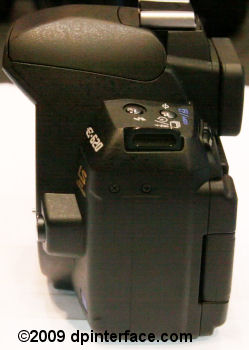
Over here is a better view of that button for ejecting the lens; otherwise, there’s nothing of interest here.
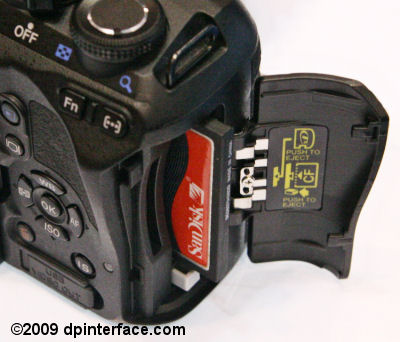
On this side of the Olympus E620 are its dual memory card slots. The E620 can take one xD-Picture card as well as a single Compact Flash card. With a UDMA Compact Flash card, the camera is able to perform quite a bit faster.

At the bottom of the Olympus E620 are its metal tripod mount (in-line with the lens) and battery compartment. The compartment door is quite sturdy and is removable in order to insert the optional battery grip’s connector.
Taking pictures (Shooting mode)
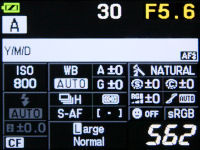
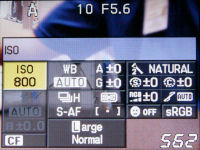
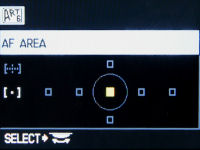
Press the OK button on the Olympus E620 and it brings up what Olympus calls the Super Control Panel. The many details and shooting aspects in the screens above are what you’ll get and from here, you can change the various settings from the on-screen items.
The Olympus E620 has 7 autofocus points when using the optical viewfinder, the center five are cross type AF points. In the camera’s live view mode, up to 11 AF points are available for selection
Live view
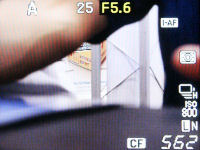
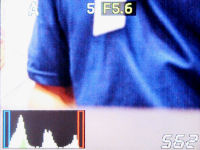
The Olympus E620 will flip up its mirror and activate live view upon the press of its dedicated live view button. The camera shows 100% of the frame with shooting and exposure information. There are also optional framing gridlines, a live histogram and focus enlargement of either 5X, 7X or 10X.
In live view, the E620 shows you a real time image preview of your picture’s exposure, white balance, gradation and even optional depth of field preview. You can even view the different effects of various settings (ie white balance, exposure) via the camera’s Perfect Shot Preview feature, which splits the screen to show four setting change effects simultaneously.
The Olympus E620 has three live view modes. First off is the traditional Phase Detect AF (aka AF Sensor mode) which blacks out live view briefly so the camera can do some mirror flipping to focus using its AF sensor, then live view comes back on again.
Contrast Detection AF (aka Imager AF mode) ensures there’s no screen blackout during AF by using the LiveMOS imaging sensor directly for focusing (just like compact cameras). Face detection can be activated in Contrast Detect AF mode too, and the E620 can detect up to 8 faces in a scene; or you can choose to use the camera’s 11 point imager focus instead (versus 7 points using the traditional AF sensor). The trade off? Contrast Detection AF is the slowest among the three live view modes and only works with a handful of lenses. The lenses that are able to work with Contrast Detection AF include the 25 mm f2.8 pancake, 14 – 42 mm f3.5- f5.6 kit lens, 9 – 18 mm f4.0 – f5.6, 14 – 54 mm f2.8 – f3.5 II and 40 – 150 mm f4.0 – f5.6 lenses.
Hybrid AF is a little bit of both of the first two modes – the camera first focuses using its imaging sensor, then when you press the shutter button all the way down, the camera ‘confirms’ focus by using traditional phase detection AF before taking the actual picture.
Multi Exposure
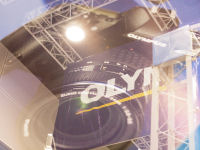
(2 shots combined in Live View mode)
The Olympus E620 features Olympus’ Multi Exposure feature (I’ve seen this on some compacts too). The Multi Exposure feature allows you to combine two or three pictures into a single image and can be done on-the-fly in live view mode or later on in playback. There’s an auto gain function you can activate and this evens out exposure of combined photos.
In shooting mode, you can combine up to two pictures and have to use live view. After you take the first photo, the image appears on-screen as a semi-transparent overlay while you compose the second shot to be combined with the first one.
The Multi Exposure feature works in playback too, where you can combine up to three photos. The catch here is that it only works on images taken in RAW format.
Shooting settings
The Olympus E620 has a whole lot of image resolution options; including 12 MP, 7.7 MP, 5 MP, 2 MP, 1 MP and VGA. There’s numerous image compression options too: Superfine, Fine, Normal and Basic, along with four aspect ratio settings (4:3 standard, 3:2 print, 16:9 widescreen or 6:6 square). RAW and RAW+JPEG modes are available, but only when using the 12 MP resolution setting. I would recommend using 12 MP with Normal compression for daily JPEG shooting.
RAW file sizes are much larger (around 14 MB per shot) versus typical JPEG shots but you’ll get complete control over almost every single aspect of the image: white balance, noise reduction, contrast, saturation, exposure, colors, etc. If you messed up some camera settings but took the picture in RAW format, then most likely you’ll be able to correct it later on your computer. You’ll probably want a high-speed memory card here so the camera can write those huge files quicker. You can store about 280 RAW photos or 750 Normal JPEG ones on a 4 GB card.
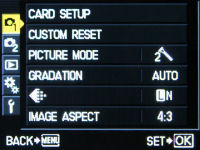
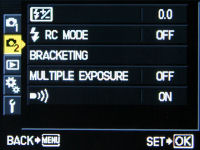
Unlike the simple grid menus on their compact cameras, the menus on Olympus digital SLRs are more comprehensive and are split into five main tabs. The first two of which on the Olympus E620 cover shooting functions:
- Card setup (Erase all, format)
- Reset settings
- Picture mode (Vivid, natural, muted, portrait, monotone, custom)
- Gradation (Auto, normal, high key, low key)
- Image resolution and compression
- Aspect ratio (4:3 standard, 3:2 print, 16:9 widescreen or 6:6 square)
- Flash exposure compensation (+/- 3 EV in 1/3 step increments)
- Wireless flash (On/off)
- Bracketing setup
- Multiple Exposure
- Camera beeps
Picture Modes
The Olympus E620 has five preset Picture Mode options with one custom option. The preset Picture Modes include Vivid, Natural, Portrait, Muted and Monotone. For all of the Picture Modes, presets and custom, you can adjust sharpness, contrast and saturation levels with 5 levels for each of them. For the Monotone option, the saturation option is replaced by Black & White filter and toning options. You can set which color to filter out (yellow, orange, red or green) and the tone of the final monochrome photo (Yellow, orange, red, green or sepia).
You can also set gradation adjustment (automatic, normal, high key or low key) which reduce the chances of blown highlights or dark shadow areas in photos, making exposure more even. High key prioritizes bright areas while low key prioritizes shadow/dark areas.
The E620 has two color space options: sRGB and AdobeRGB.
Bracketing
The Olympus E620 features several bracketing features – four of them to be precise. There’s exposure bracketing which takes three shots in a row in 1/3, 1/2 or 1 step, as well as flash intensity bracketing, which does the same up to +/-3EV in terms of flash exposure compensation.
There’s ISO bracketing which takes three photos in a row also, in 1/3, 2/3 or 1 step increments. Finally, there’s white balance bracketing if you’re using the white balance adjustment setting. You can take three pictures in a row up to +/- 2, 4 or 6 on each axis (amber-blue or green-magenta)
Custom Function menu
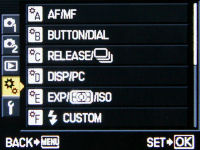

The Olympus E620 includes many custom functions, which are organized into nine categories:
- A. Autofocus/Manual focus section – Select Live View mode (covered in the sub-section above), toggle AF assist, select autofocus area, mode and AF point size and focus ring direction
- B. Button/dial programming – Determine the camera’s actions/functions when you turn the top command dial, press the AE/AF lock button, Function button and Drive mode button at the top. You can also set 2 My Modes and button inactivity period
- C. Release priority (determine whether the camera takes a picture even if focus isn’t locked) and set low-speed continuous speed (between 1 to 3 frames per second)
- D. Display/PC – Set TV/PC connectivity settings, toggle live view boost & face detection and amount of information shown in shooting/playback
- E. Exposure/Metering/ISO – Set ISO and exposure step increments (1/2, 1/3 or 1 full stop), Auto ISO range, preset bulb mode period and mirror lockup delay
- F. Flash settings – Set flash sync speed, flash exposure compensation and auto popup when using auto or one of the camera’s scene modes
- G. Quality/Aspect/Color/White balance – Set noise reduction, white balance settings, vignetting reduction, image resolution and aspect ratios available to choose from
- H. Record/Erase – Determine how the camera names picture files (default is Pxxxyyyy where x is the folder number, y is the image number), set primary/secondary memory card order and a whole lot of settings covering ‘how photos are deleted’
- I. Utilities – Pixel mapping, external white balance sensor, sensor cleaning, exposure shift, battery warning and ‘AF Focus Data’
There’s one feature worth covering from the AF/MF section – since Four Thirds lenses use electronic manual focusing (The lens is electronically directed when you turn the focus ring; not direct control over a focus element), you can choose whichever turning direction you’d like to use with the camera. That’s quite a neat feature.
Not only can you control the focus ring direction, but the Olympus E620 also offers a lot of customization in terms of its controls. You can set the action and direction of the command dial as well as three of the camera’s buttons.
The Olympus E620 features a mirror lock up function, which Olympus calls Anti Shock Release, and you can select the delay time from 1 to 30 seconds.
I’ve explained pretty much everything of the next few sections in the Custom Menu and we’ll head on to the Utilities section which holds two very interesting features. The Pixel Mapping feature allows you to map and remove hot pixels and dead pixels from the camera’s sensor. There’s also AF Focus Data, a HUGE feature that all digital SLR ought to have (If you’ve owned a digital SLR with many lenses over the years, you’d agree with me) – it allows you to tune up to 20 lenses to compensate for front/back focus up to +/- 20 steps. I don’t think any of the Olympus E620’s direct competitors have such a useful feature.
Admittedly, there are some aspects of the camera that shouldn’t be buried inside the Custom Function menus – such as some of the live view settings and noise reduction/white balance/resolution as well as ‘how photos are deleted’. If you’ve never used a digital SLR (or an Olympus one) before, reaching them may require some browsing around the menu, or even consultation of the camera’s user’s manual.
Setup menu
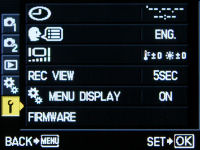
The final tab in the E620’s menu system covers setup (I’ll talk about the Playback section later). There are only six items in this part of the menu:
- Set date and time
- Set camera language
- LCD brightness and color
- Image review time
- Display custom functions menu
- Camera and lens firmware version (The firmware version of this Olympus E620 unit is v1.00)
Other scene modes and macro
I’ve already talked about the scene modes you can access directly from the E620, so why not cover the remaining scene modes selectable via the Art Filters/Other Scene mode position. The other scene modes available on the camera include children, high key, low key, digital image stabilization (This merely boosts ISO as high as needed), nature macro, candle, sunset, fireworks, documents, panorama, beach & snow, underwater macro and underwater wide.
The minimum focusing distance depends on the lens being used on the camera. Olympus makes two dedicated Four Thirds macro lenses – the 35 mm f3.5 macro and 50 mm f2.0 macro.
Video Recording
The Olympus E620 doesn’t have a movie mode. There are only four digital SLR cameras in the market right now with movie modes but the E620 isn’t one of them.
Performance
All performance testing of the Olympus E620 was performed using a high-speed 4 GB SanDisk Extreme IV Compact Flash card. A high-speed memory card is definitely recommended if you want to get the most out of the camera in terms of performance.
The Olympus E620, like its more expensive sibling, the E30, uses the new True Pic III Plus imaging processor. The Olympus E620 manages to start up in about 1 second, after completing the dust reduction process. Focusing speeds will depend largely on lens choice – using the 14 – 42 mm kit lens, auto focusing can take between 0.2 to 0.6 seconds, longer if lighting isn’t that good.
Live view focusing using Phase Detection AF will add around 0.6 seconds of delay while Contrast Detection AF is much slower with an additional delay of 2 to 3 seconds. Hybrid AF adds about 1 to 2 seconds to focusing times if you just jam down the shutter button. The camera has a built-in flash strobe AF-assist system but it becomes unavailable in live view mode; or if you want even better & faster AF-assist, external flash units have a laser-based system.
- Shot-to-shot speed - 1 shot as fast as you can press the shutter button; very fast
- Flash recharge time using a fully charged battery - 4 seconds on average (built-in flash)
The E620 has two continuous shooting modes: low and high speed. You can select frame rate from 1 to 3 frames per second in low speed mode. In high speed mode, the E620 shoots at a frame rate of about 3.9-4.0 frames per second until the card fills up with Large/Normal JPEG photos or up to 7 to 8 RAW photos per burst. While camera’s continuous shooting performance is impressive when shooting JPEGs, I think there’s still room for improvement in terms of burst length for RAW images.
The Olympus E620 performed very well – with good focusing times, the ability to shoot as fast as you can compose pictures and a nice burst mode (when doing JPEGs, not so with RAW). The areas where the camera could’ve done better include focusing in live view mode (slow live view focusing is a problem that plagues just about all digital SLRs) and increased buffer depth for RAW images.
Image Quality
Time to take a look at the Olympus E620’s image quality:






Update: All test shots, here and in the photo gallery, were taken using the ‘Natural’ Picture Mode with Noise Reduction off and distortion control off.
Update #2: The test was conducted with Gradation set to Auto, but apparently the difference is unnoticeable when using Auto vs Off in low-light. In outdoor/bright light scenes, you WILL see a difference as the camera decreases contrast slightly to bring out shadow areas while preserving details in bright areas.
Photos start out looking clean at ISO 100, with noise increasing very slightly in the ISO 200 and 400 crops. Don’t fret though; image quality is still more than usable here. At ISO 800, there’s additional noise but nothing to worry about yet.
At ISO 1600, more noise comes into play and there’s even more at ISO 3200. The noise levels here are higher than that of competing 1.5X/1.6X digital SLR cameras. If you’re prepared to shoot in RAW and do some post-processing on your computer, go ahead and use the ISO 1600 and 3200 settings. Otherwise, I’d recommend sticking to ISO 800 and below for casual JPEG shooting.

Lens distortion, edge sharpness and color fringing (chromatic aberration) are highly dependent on what lens is being used on the camera. With the Olympus Zuiko Digital 14 - 42 mm kit lens, there was relatively low lens distortion and color fringing (chromatic aberration) but edge softness was still quite apparent, higher than I would have liked. Center sharpness was decent, though if you’ve used higher end lenses before, you’d be spoilt by their quality.
As with just about all camera lenses, you pay for what you get – more expensive lenses tend to bring better, more pleasing results. Using the high end Olympus 14 – 54 mm f2.8 – f3.5, the E620 managed to produce more brilliant looking photos with excellent center sharpness and good edge-to-edge sharpness.
Though it may vary, redeye was not an issue when using the E620’s built-in flash. Even if any shows up in your photos, you can use the software-based redeye removal tool in playback to get rid of it. If you need more flash power or eliminate redeye completely without bothering with the playback tool, then you can get an external flash to go with the camera.
The Olympus E620 managed to produce nice, clean and sharp photos at ISO 800 and below. Using the ‘Natural’ setting, colors here looked a little bland for my taste, but this is subjective – you can always change Picture Mode; Vivid for punchy colors or Muted for even more subdued colors. Noise was slightly higher than competing cameras, but it isn’t something that comes as a surprise – the Olympus E620 uses a smaller 2X crop sensor versus the 1.5X/1.6X crop APS-C sensors of its competitors. Of course, with larger sensors come larger lenses and bodies, so a slight increase in noise is a good compromise for those who place priority on portability and travelling light (or just don’t want to break their backs with a bag full of lenses).
In terms of dynamic range, the E620 performs decently for a digital SLR, though it has a tendency to blow out highlights in very contrasty scenes. Setting gradation to Auto or On will help in brightening dark areas of photos but this is only effective in well lit conditions. In low-light, the difference is unnoticeable.
Photo gallery
Check out full-sized, unedited photos taken straight out of the camera in the Olympus E620 photo gallery.
Playback
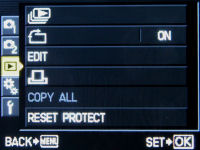
The Olympus E620 has a very good playback mode. You can play back photos with 14X magnification available to confirm focus and details. The usual playback basics such as print marking, slideshows, image protection and auto rotation are here.
You can playback photos individually, by date in calendar view or your choice of 4 to 100 thumbnails! There are a plethora of handy features in the E620’s playback mode under the ‘EDIT’ section. I’ll talk about RAW edit first – this feature allows you to process RAW files into JPEG photos directly in the camera. You won’t get a whole comprehensive suite of controls and features as you would in a computer; but I suppose the main use of this feature is to conserve space, if you suddenly change your mind about a photo shot in RAW and think ‘JPEG is good enough’ for it.
In terms of JPEG editing, you can apply Shadow Adjustment (brighten dark areas of your photos), redeye removal, adjust saturation and change the aspect ratio of photos. You can also resize pictures or convert them into black & white or sepia, if desired.
There’s also a ‘split screen’ view where you can compare two pictures side-by-side and a ‘copy’ function to move your photos between the camera’s Compact Flash and xD-Picture cards. Obviously, you’ll have to fill both slots with their respective cards for this to function. The best part? In addition to select one and select all photos for the E620’s copy and erase features, you can select multiple photos on your own.
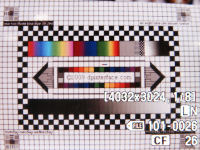
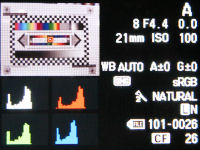

By default, the Olympus E620 only shows the image resolution/compression and shutter speed of your photos. Press the INFO button and the E620 brings out a lot more information: from shooting details, mode, full exposure information (with shutter speed and aperture value) and four histograms on screen – Brightness and RGB! There’s also a highlight/shadow alert feature which “blinks†both underexposed and overexposed areas of your photos to warn you about them.
Conclusion
The new Olympus E620 is a very interesting and capable digital SLR – no wonder everyone’s talking about it (and that explains the many emails from readers asking me to review it). The E620 takes many of the things that makes its big brother, the E30, great – including 12 megapixels of resolution, rotating 2.7 inch screen (now with the new Hyper Crystal III coating) with good visibility, good performance, most of its feature set (including Art Filters) and wireless flash setup capabilities – and puts those features into a form factor the size and shape of the relatively compact E520.
As mentioned, the Olympus E620 is quite small for a digital SLR, and the smallest and lightest with built-in image stabilization, so says Olympus. The camera is easy to hold and has fairly good ergonomics; though it suffers from being overloaded with too many buttons and some of them are difficult to press. Once you get the hang of the E620, though, you’ll appreciate its control setup with each button dedicated to one function and the fact that several of the controls are backlit for easy visibility of their labels in the dark. Live view was well implemented, though slow, and that rotating LCD really comes in handy when paired with live view.
The camera has an average bundle with decent battery life that you can double via the optional battery grip. Naturally for a digital SLR, there are lots of other accessories available for the E620, but strangely, no AC adapter. The Olympus E620 also supports wireless flash setup and control right out of the box, that’s great.
The Olympus E620 has a full suite of manual controls, including the ability to take RAW photos and develop them in playback mode, advanced white balance control and numerous bracketing functions. There’s also a total of nine categories of custom functions on the camera, including the ability to tune individual lenses to compensate for front/back focus (None of the competition in this class have this feature!). But of course, Olympus didn’t leave casual shooters and beginners out in the cold either – there are plenty of scene modes on the E620 as well as the ability to apply special effects to photos as they are being taken via the Art Filters feature and combine two/three photos via Multi Exposure, which will appeal to beginners and enthusiasts alike. Just be aware that using both Art Filters and Multi Exposure may slow down shot-to-shot times due to the additional processing needed.
Performance was quick as well; the Olympus E620 had no problems keeping up, even when constantly shooting several pictures in a row. Continuous shooting of JPEG photos was excellent – with a high-speed card, the E620 can fill up the whole card with 12 MP Large/Normal photos. RAW continuous shooting on the other hand, was less impressive; the camera still shoots at the same nice 4 FPS but the number of shots you can take is quite limited (usually just 7 or 8 RAW images). Autofocus ‘the normal way’ (optical viewfinder) was snappy but focusing in live view mode takes much longer and is suited for shooting of still subjects only. Speaking of optical viewfinder, the one here on the E620 is a tad smaller than those on cameras which are physically larger and house bigger imaging sensors/mirror boxes.
Image quality of the Olympus E620 was generally good – the camera took nicely exposed photos with good color accuracy, sharpness and images were clean at ISO 800 and below. Though it can’t be denied that some of the E620’s 1.5X/1.6X crop APS-C format competitors produce slightly cleaner images, you have to take into consideration the fact the E620’s 2X crop Four Thirds sensor is smaller than the sensors of its competitors.
The Olympus E620 is a nice little digital SLR that I would highly recommend. It has lots of great features – some of which like lens fine tuning, dual card slots and RAW development aren’t even available on most cameras of this class. If you’re looking for a relatively compact and feature-packed digital SLR for 700 bucks or below, then the Olympus E620 is it.
What’s hot:
- Good image quality
- Rotating 2.7 inch LCD with good visibility
- Compact design with backlit controls (some) and dual memory card slots
- Live view paired with rotating screen is useful; shows a live histogram and manual focus enlargement
- Full manual controls; flash hotshoe, RAW image mode and white balance tuning
- Decent battery life with portrait battery grip available
- Art Filters ; good selection of scene modes for beginners
- Fast performance; very nice continuous shooting mode
- Built-in lens front/back focus tuning
- RAW to JPEG processing and many JPEG editing features in playback
What’s not:
- Slightly higher noise versus competition with bigger sensors
- Optical viewfinder is on the small side
- Limited RAW buffer in burst mode
- Slow autofocus in live view mode
- Some buttons are small; and there’s too many of them
- No settings to tweak Art Filters; increased processing times when using them
Recommended Accessories:
- 4 GB or larger high-speed CF memory card


Question: what were the NR and SAT settings on the test shots?
Thanks for this great informative review!!
after reading your review, I am going to buy this camera right now
@David
All the test shot photos and photos in the E620 gallery were taken with Noise Reduction set to off, Shadow Adjustment off, Natural Picture mode with Auto gradation
@Sergie and Paul
Glad my review was useful =)
Hi Brad,
Shadow adjustment off with Auto gradation on? I believe both are the same thing. You should turn off auto gradation for the iso test.
You are saying, “Shadow Adjustment off” and “Auto gradation”.
These statements are mutually exclusive.
If the gradation setting was on Auto, it means SAT was ON.
Gahhh… what was I typing… my apologies, that’s what happens when I attempt to multi-task too much - trying to read emails while replying to comments at the same time.
Correction: It should have read Gradation/Shadow Adjustment set to Auto
Thanks for pointing out guys =). I shot two sets of the ISO test and apparently gradation on auto vs off doesn’t make a noticeable difference when shooting in low-light. In bright conditions/outdoors, yes it does make a difference in bringing out shadow areas in photos.
Updates:
-Added clarification in Image Quality section:
“The test was conducted with Gradation set to Auto, but apparently the difference is unnoticeable when using Auto vs Off in low-light. In outdoor/bright light scenes, you WILL see a difference as the camera decreases contrast slightly to bring out shadow areas while preserving details in bright areas.”
-Added comparison to new Nikon D5000’s dimensions and battery life
Having completed your review of the camera, are you planning to review the Olympus E30 anytime soon? Would you recommend the E620 over the E30, seeing that they have such similar features but one costs almost twice the price, $600 over the other?
does this camera have a spirit level display like the Nikons? Art filters are firmware updates right?
Stumbled upon your review from one of the posts on 4/3rds Rumors. I bought an E620 from Olympus Netherlands 2 weeks ago as a backup body to my E3. Brad is right about gradation not making a difference when not shooting in places with good-very good lighting.
I should point out Olympus in Europe calls it Shadow Adjustment Technology while Olympus America calls it Gradation adjustment.
“Though it can’t be denied that some of the E620’s 1.5X/1.6X crop APS-C format competitors produce slightly cleaner images”
-Is that just in higher iso over 800 (where I know there is quite a difference), or at let’s say iso 100-200 too (where I usually shoot). Im looking for a new dslr, I have the E500, and the E620 is promising, but Im eyeing the Canon 500d too.
Noise is not the only factor of course in my descion, but it does matter, esp the levels on low iso.
@Vince
As I’ve still got quite a number of cameras sitting here to be reviewed, expect the E30 review somewhere next month at least.
@Armando
No, the E620 does not have a spirit level display (for that, you’ll have to go for the E30).
@Vikki
You’ll notice the difference when using higher ISO speeds (ie 800, 1600, 3200). At lower speeds like 100-400, the difference is negligible - pictures are clean and you could pretty much do anything with them, like make large prints.
As for the comparison vs the Canon 500D or Nikon D5000, I’ll have to get those cameras on my desk first =) but I’m not sure so I can’t say when yet.
I’m so surprised there are few cameras in this price range with lens/body focus calibration as olympus calls “AF Focus Data,”. So many stories (probably a small %) of users having to return nikon, canon bodies for calibration.
Maybe the panasonic Gh1 with super-fast contrast detect is the way of the future? but until we have the super fast processing speed we’re going to have to stick with phase. At least the Oly helps with both speed and accuracy through the calibration option.
Is there a remote wired shutter release? I found this article using those key words but cannot see reference to it. I want to mount this on a helmet for freefall camera work and have to operate the shutter with my mouth
Hi Daryl, yes I listed the wired remote control as one of the accessories for the Olympus E620. The wired remote is connected via the USB connectivity port (as opposed to dedicated remote control ports on some Canon and Nikon SLRs).
I purchased the Olympus E620 yesterday (6/14/09) after trading in one of my film SLRs and two lenses. So I ended up with a pretty good price in the end which included the kit lens, 4mb card, extra oly battery and 3 year warrenty. All for $552.54. I took the E620 out for a spin that very afternoon. Since I do mainly street photography and rely on smallish cameras with fast prime lenses I wasn’t sure how this camera and lens would do. I pretty much kept the lens on it’s 14(28) setting and found that the system responded pretty well. Yes it’s a slow lens at 3.5 but with digital you have software to brighten things up. I have a feeling the E620 and I are going to get along just fine.
is it being made in china a factor about its quality? in the long run.
Hmm, I'm sure cameras in general will hold up to a few years of usage, but I'm not quite certain how significant a role manufacturing location plays in the “number” of years the camera will hold up. Many consumer electronics such as mobile phones, laptops and household items are usually made in China as well.
It depends on your luck I guess. I had a “made in Japan” Digital ELPH a few years back which died because of the then-dreaded E18 error (shrug).
i’m a new user for this camera, as well as dslr camera…juz wondering, is it normal when capturing pictures, the flash keep on turning, but there’s no pic been taken?
Hi, that’s the autofocus assist feature where the flash will fire some light to help the camera to focus.
I just have to say I decided in the end on this cam, bought it on July 23rd. I am happy, I cannot believe how useful the in body IS have been at times, and also how much I have loved the swivel lcd. This cam is a joy to shoot with, and in combination with the 9-18mm wide angle I have had some great fun. I do NOT regret my decision, the Canon is a great cam as well, but I love those features I just mentioned, and they have outweighed what I loose in shooting on high iso (which I seldom do anyway).
Hi Brad ,
i’m surprised that e620 does not have a video recording capability as i believe it’s a great miss .
Sometimes we just want to record moments rather than still pictures .
Indeed, I too, am puzzled with Olympus’ behavior, whatever their strategy may be. The only big sensor camera with a movie mode they have now is the Micro Four Thirds E-P1 Pen. Maybe they’ll have digital SLRs with movie modes next year in 2010
Video would be nice but I wouldn’t necessarily expect it at this price point.
Hi, I am hoping you can help me choose the best DSLR as i am a complete newbie and have no idea what I should be looking for. I want a camera that will last for many years. I am looking at the Olympus E620 & the Canon EOS 500d - what should I go for? Any guidance will be appreciated.
Unlike other brands, when the Noise Filter is Off, it really is off on Olyumpus, meaning that you will have a lot of noise from the start.
In other sites tests were made with NF to *Low*. The manual itself suggest setting it to Standard below 800 ISO and to High, above that.
I can personally vouch for the absence of noise in good light even by using Standard at 800 and 1600 ISO.
Moreover if you leave Gradation on Auto you will *add* unnecessary noise by recovering the shadows: insteadi t should be set to Normal.
By using your settings you have produced a maximum amount of noise, thus biaising the test.
By comparison C & N will always have a level of filtering by default. Therefore the only way to compare is RAW.
When doing that one notices that the noise levels are very similar up to 800, then APS being bigger has a slight advantage.
Does the Olympus E620 have a manual focus? I cannot seem to work it. All I can use is the auto focus.
Hi Laura, you first need to switch focus mode to MF before turning the focus ring. As the manual focus system of Olympus and Panasonic’s Four Thirds/Micro Four Thirds cameras are all electronically assisted (means nothing happens if you turn the focus ring without going to MF/Manual Focus mode first), you MUST change the focus mode.
Hope this helps, Brad
Laura, re manual focus: with my sigma lenses there is a switch I can flip on the lens itself when I want manual focus, with my Olympus lenses I like Brad says have to swop to manual focus (MF) via the focus button (says AF on it, the one to the right of the OK button and just above the IS button, at the back) or via the quick menu (or delve deep down into the regular menu system). I am lazy, so I have assigned my Fn button to do that switch for me, since I want to be able to very fast access MF sometimes. Good luck!
Just bought E-620 how does the image stab on my cheap camera it would like lock image
this doesn’t do that I have it on frist setting thanks for any help
please, I want to know if it is possible to adjust the back-lightning of the button and how to do it, thank you